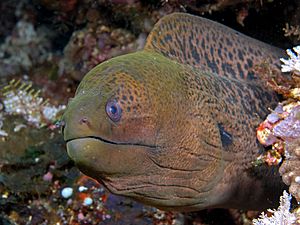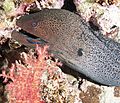Giant moray facts for kids
Quick facts for kids Giant moray |
|
|---|---|
 |
|
| Conservation status | |
| Scientific classification |
The giant moray (Gymnothorax javanicus) is a very large type of moray eel. It is a fish that lives in the ocean. This amazing creature is the heaviest moray eel, but another kind, the slender giant moray, is longer.
Contents
About the Giant Moray
The giant moray is a truly big eel! It can grow up to 3 m (9.8 ft) long. That's about the length of a small car! It can also weigh up to 30 kg (66 lb), which is like a medium-sized dog.
Its long body is usually brownish. Young giant morays are tan with big black spots. As they get older, the spots change. Adults have small black specks that turn into leopard-like spots behind their head.
Where They Live
Ocean Home
The giant moray lives in many parts of the Indo-Pacific region. You can find them from the eastern coast of Africa, including the Red Sea, all the way to the Pitcairn group. They also live near the Hawaiian islands and in Polynesia.
Further north, they are found near southern Japan. To the south, you can see them around New Caledonia, Fiji, and the Austral Islands.
Their Habitat
Giant morays like to live in lagoons. They also live on the outer slopes of coral reefs. During the day, they hide in cracks and holes in the reef. They can be found in water from 1 to 50 meters deep.
What They Do
Hunting for Food
The giant moray is a carnivore, which means it eats other animals. It is also nocturnal, so it hunts for its food at night. It searches for prey within the reef.
Sometimes, giant morays work together to hunt! They team up with a fish called the roving coral grouper (Plectropomus pessuliferus). These two fish are great hunting partners. When the moray hunts inside the reef, it might scare prey out into the open. The grouper then catches the scared prey. In the same way, if the grouper hunts above the reef, it might make prey try to hide in the reef. That's where the moray can ambush them!
What They Eat
Giant morays mostly eat other fish. Sometimes, they also eat crustaceans, like crabs or shrimp. Recently, scientists found that the giant moray is a natural hunter of the lionfish (Pterois miles). This happens in its home area, the Red Sea.
Natural Enemies
A grown-up giant moray has very few natural enemies. However, they might compete for food with sharks that live in the reef. You can often see small fish called cleaner wrasses near morays. These wrasses swim into the moray's mouth and clean it!
How They Hunt
Scientists have found that Gymnothorax javanicus has a very small part of its brain for seeing. This means they mostly hunt by smell, not by sight.
Staying Safe Around Them
Food Safety
Giant morays can be risky to eat. Because they are at the top of the food chain, they can build up harmful toxins in their bodies. This is called biomagnification. These toxins can cause a type of food poisoning called ciguatera. Eating a giant moray, especially its liver, can make people very sick. It can even cause serious health problems.
Their Behavior
Giant morays are not usually aggressive. However, they might bite if they feel threatened. They might also bite if they are cornered or if there is food nearby.
Gallery
Images for kids
See also
 In Spanish: Morena gigante para niños
In Spanish: Morena gigante para niños






